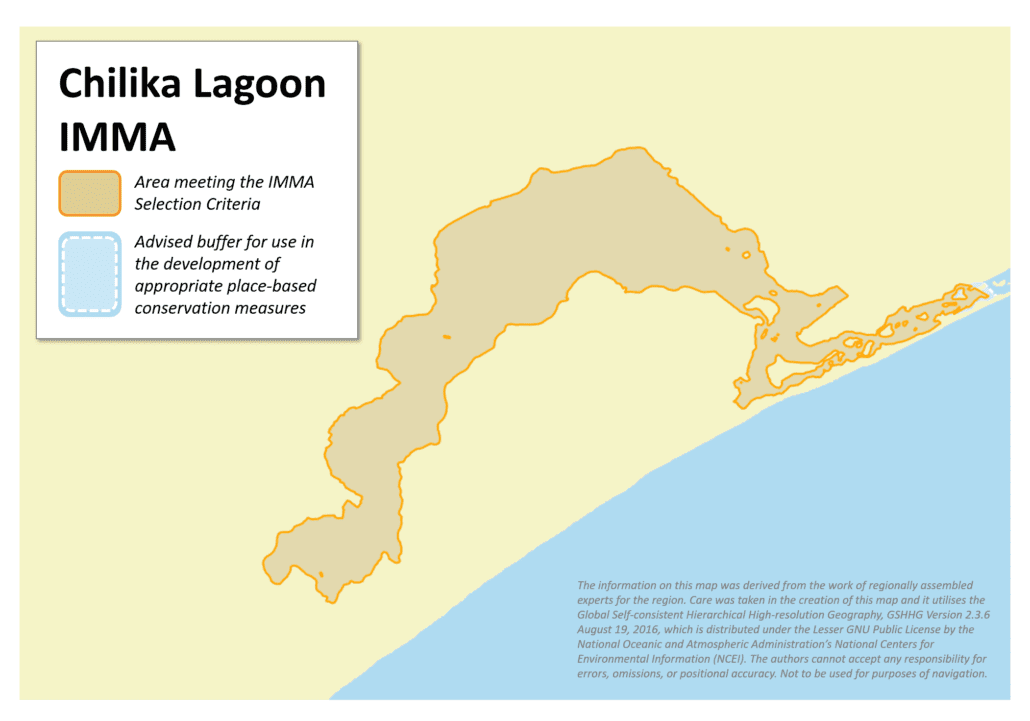Chilika Lagoon IMMA
Size in Square Kilometres
319 km2
Qualifying Species and Criteria
Irrawaddy dolphin – Orcaella brevirostris
Criterion A; B (1)
Download fact sheet
Summary
Chilika Lagoon is a brackish water lagoon in southern Orissa, India. The lagoon is separated from the Bay of Bengal by a spit which is 1-1.5km wide and 20 km long. The opening to the sea varies in position and width after every monsoon. A small population of 112-140 Irrawaddy dolphins, Orcaella brevirostris is resident in Chilika lagoon based on photo-identification studies from 2003-2010. Mating chases were observed from February to April; and calf sightings peaked in December-January. Dolphins were observed feeding on a range of bony fishes, scat fishes, Scoliodon and mullet. There is no known movement of dolphins from or into the lagoon, with humpback dolphins and Bull sharks dominating the coast outside the lagoon. Documentation of Irrawaddy dolphins outside the lagoon is from the mangroves of Bhitarkanika, 250-300 km north of Chilika. The primary threats to the population in Chilika is fisheries entanglement and unmanaged dolphin-watching tourism.
Description of Qualifying Criteria
Criterion A – Species or Population Vulnerability
Irrawaddy dolphins are listed as globally Endangered and decreasing by the IUCN Red List of Threatened Species (Minton et al. 2018). The estimated population in this IMMA is small at 112-140 (Sutaria, 2009). The population in Chilika is also resident based on photo-identification data from 2004 to 2010, making Chilika an important area for this species. In Chilika, Irrawaddy dolphins live in close proximity with intense fishing activities and mortality rates reached as high as 7% (Pattanaik et al 2007, Sutaria 2009, D’Lima 2014), primarily from fisheries entanglements. Such high mortality rates makes the population vulnerable to stochastic and anthropogenic pressures (Sutaria 2009). Habitat loss from the accumulation of silt is one of the major pressures on this brackish water system.
Criterion B: Distribution and Abundance
Sub-criterion B1: Small and Resident Populations
Chilika supports a small population of resident Irrawaddy dolphins, physically isolated from coastal populations, vulnerable to fisheries entanglements, un-managed dolphin watching tourism traffic and habitat loss. Given that the population is resident, and spends its entire lifecycle within the lagoon, Chilika is an area that is additionally important for breeding and calving. Mating chases were observed where the chased individual was seen belly-up with other individuals on top (Sutaria 2009). The Outer channel of the lagoon had a higher density of mother-calf pairs and juvenile than the rest of the lagoon, and new- born calves showing foetal curves were also sighted with adults (Sutaria 2009, D’Lima 2014). Mark-Recapture analysis of 80 photo-identified individual dolphins using natural marks estimated the abundance of the population as 109 to 112 individuals at CV=0.07 (closed models); and 140 at CV=0.25 (open models), based on surveys from November 2004 to December 2006 (Sutaria 2009). Their area of space use is not more than 400 km2 with individual home-ranges as small as 1.7 km2 showing how sensitive the population cold be to changes in habitat features such as depth and salinity. The lagoon is highly productive, providing a rich source of prey to the dolphins. Multiple foraging strategies – both solitary and cooperative group foraging have been observed in Chilika (Sutaria 2009, D’Lima 2014). Coastal surveys of Orissa have not sighted another such resident population (Sutaria 2009, Orissa State Forest Department) making the population in Chilika an important source population for the species in India and regionally. The closest Irrawaddy dolphin sightings outside Chilika, are upstream in the mangroves of Bhitarkanika, 250-300km north of Chilika.The IUCN Red List of Threatened Species lists all other isolated and semi-isolated populations of Irrawaddy dolphins in the species’ range as Critically Endangered.
Supporting Information
D’Lima, C. 2014. Striking a balance between fishing, tourism and dolphin conservation at Chilika Lagoon, India. PhD thesis, James Cook University. Townsville, Australia.
Minton, G., Smith, B.D., Braulik, G.T., Kreb, D., Sutaria, D. and Reeves, R. 2017. Orcaella brevirostris (errata version published in 2018). The IUCN Red List of Threatened Species 2017: e.T15419A123790805. http://dx.doi.org/10.2305/IUCN.UK.2017-3.RLTS.T15419A50367860.en. Downloaded on 25 October 2018.
Sutaria, D. 2009. Understanding species conservation in complex socio-ecological systems: case of Irrawaddy dolphins in Chilika Lagoon, India. PhD thesis. James Cook University, Townsville, Australia
Sutaria, D. and Marsh, H. 2011. Abundance estimates of Irrawaddy dolphins in Chilika Lagoon, India, using photo-identification based mark-recapture methods. Marine Mammal Science 27(4): E338-E348.
Sutaria, D., Bopardikar, I., and Sule, M. 2017. Irrawaddy dolphins, Orcaella brevirostris from India. Primary paper SC/67A/SM/08. International Whaling Commission. Slovenia
Pattanaik, A. K., Sutaria, D., Khan,M., and Behera, B. 2007. Review of the Status and Conservation of Irrawaddy Dolphins Orcaella brevirostris in Chilika Lake of India. Working paper series # 31. In ‘Status and conservation of freshwater populations of Irrawaddy dolphins’ pgs 41-52. Wildlife Conservation Society, Pnom Penh, Cambodia.


